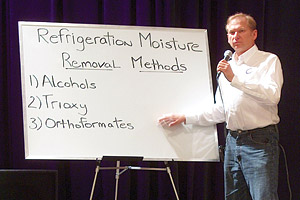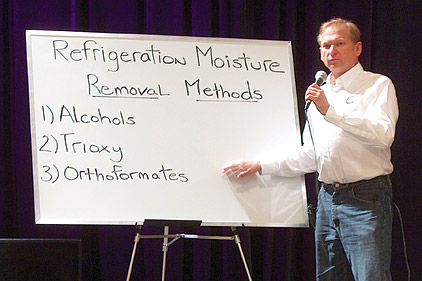
|
| Paul Appler discusses moisture-related problems during a State of Alabama Continuing Education Program for HVACR contractors. |
“An epidemic of moisture-related problems are causing more system failures today than ever before in the history of air conditioning and refrigeration,” said Paul Appler, a technical speaker at the state of Alabama’s mandated Continuing Education Program for HVACR Contractors.
Appler, director of research for Cliplight Manufacturing, presented the state-approved Repair and Servicing R-410A/POE and R-22/Mineral Oil-Related Systems last spring to classes of HVACR service techs at the Alabama Johnstone Supply branches of Birmingham and Huntsville.
“I think service techs are finally understanding that moisture is now public enemy No. 1 based on the many moisture-related questions they asked during the four-hour class,” said Larry Brudi, the program’s host and owner of five Johnstone branches in north central Alabama and middle Tennessee.
While HFC-410A/POE systems readily react with water or hydrolyze to form acids and alcohol that lead to accelerated system corrosion, Appler said HCFC-22/mineral oil systems can also develop similar problems such as waxing particulates that restrict thermostatic expansion valves (TXV). “Moisture is an old adversary regardless of the system, but now it’s even more threatening because of the efficiency advancements of today’s systems,” said Appler.
Appler said that chemical-based drying agent additives, triple evacuations, liquid line drier replacements, and other technology can help remove, prevent, and greatly reduce system moisture. When combined with industry-accepted repair fundamentals, moisture-related problems can be virtually eliminated or at least minimized, Appler said.
Shortening Triple Evacuation Time
Commercial refrigeration service contract customers typically can afford their service company’s lengthy full-fledged triple evacuation procedures that ASHRAE recommends to boil off moisture in a system, according to Appler. However, the average residential central air conditioning customer typically can’t afford two to four-hour service calls. “ACR associations recommend a pull-down between 500 to 1,000-microns with the ability to hold the vacuum for at least an hour, but residential techs don’t have that kind of time or don’t feel comfortable billing customers for it,” said Appler.
Instead, Appler recommended a leaner five-step evacuation approach that reduces service time on residential air conditioners while still ensuring the greater amount of moisture is removed. The steps are:
1. Using a two-stage vacuum, pump and evacuate down to 1,000-microns.
2. Once 1,000 microns is reached, immediately break vacuum with 15-psi nitrogen and hold for 10 minutes.
3. Evacuate to the 500 to 700 micron level.
4. Immediately break vacuum again with 15-psi nitrogen and hold for 3 minutes.
5. Evacuate down to 500 microns and hold for 10 minutes.
On a typical residential unit, holding 500 microns for 10 minutes without any gauge movement indicates a relatively leak-free system, according to Appler. If the system moves up to 2,000 microns and holds there, it indicates moisture remains in the system and steps 1 through 5 must be repeated. If it surpasses 2,000-microns, the system is leaking and may also potentially have moisture.
Chemical-Based Drying Agent Additives
“Triple evacuations and liquid line driers, as critical and effective as they are, probably will never totally rid the system of all moisture, particularly in POE oil systems,” said Appler, who performed a live demonstration in the classes showing residual moisture. “Therefore, the right chemical drying agents will aid evacuations and driers in moisture removal and make a huge difference in your service success and billing time. But it’s important to know the different types of chemical drying agents and how they work scientifically.”
He noted that chemical driers fall under three main categories: 1) alcohols; 2) vinyltrimethoxySilanes; and 3) orthoformates. These chemicals are distributed in the HVACR industry under many brands, all which have material safety data sheets (MSDS) listing their contents, according to Appler.
Alcohols: Several industry drying agents use methanol, ethanol, isoproponol and other alcohol-based chemicals, according to Appler. They can either be poured from a bottle into an oil injector tool or a charging hose, or contained in syringe-type devices, as well as hydrocarbon-charged canisters. They don’t proactively remove the moisture, but in a reactionary strategy, they prevent it from forming ice crystals that can block TXV orifices or capillary tubes. The ice crystal prevention is the same strategy used in glycol systems. Alcohols are a quick temporary fix for a problem, such as frozen TXV’s in a walk-in cooler that can’t be shut down for moisture removal because there’s no alternative food storage.
Vinyltrimethoxysilanes: They have been used solely as a drying agent in the automobile air conditioning industry. They are sold in a syringe tool or canisters using HFC-134a or a hydrocarbon as a propellant. Vinyltrimethoxysilanes are a reactive compound that doesn’t remove water molecules, but instead reacts with the moisture to form globular, soft polymers that could collect particulates that could potentially cause flow resistance and orifice restrictions.
Orthoformates: They are a reactive chemical that actually breaks apart H2O molecularly into ethanol and menthol. “You might be asking yourself, what’s the difference because both the alcohol-based and orthoformates chemical driers end up as an alcohol in the system, but the difference is the orthoformate system has eliminated water while the alcohol-based driers only mask it,” said Appler. “Orthoformates, because of their high reactivity and aggressive nature toward water, eradicate H2O in a two-stage attack.”
He said orthoformates can only be packaged in a vacuum-packed can, or else they would start working before applying them to a system. Once connected to the low side of an off system, the vacuum-packed can allows the system’s refrigerant to charge the can, then inject it into the system when the system is switched back on. This transfer prevents the product from being exposed to atmosphere or a primary propellant, he said.
Publication date: 10/17/2011


Report Abusive Comment